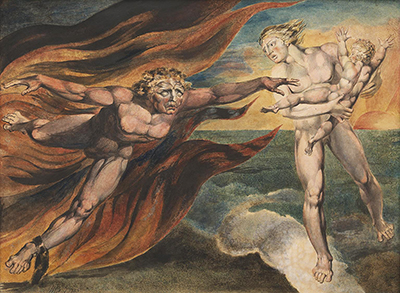The Good and Evil Angels was written by William Blake in 1795 but not published until 1805 (Blake). During these years, Blake was still creating and developing his style, which blended aspects of Gothic with Romantic elements. This obviously adds some difficulty to the analysis, particularly in defining the present themes. However, certain themes can be found throughout the book.
Analysis and Themes
Two predominant themes include reason and emotion, one being good (reason) and evil (emotion). These themes are reflected in the characters of Urizen and Luvah, respectively. Both were sons of Los, and both represent their father's ability to create on a mental level, with the former representing reason and rational thinking while the latter represents emotion and creativity.
The story encompasses an epic battle between these two characters, as Luvah attempts to gain the supreme power in heaven. However, not all of the characters represent these themes. For example, Urthona is Luvah's brother and represents his creativity; he interferes with Luvah's attempt to overthrow Urizen by giving him a sword when he has no hands. The other significant character that has not been discussed is Tharmas, who represents love and charity. He intervenes during Luvah's attempt to overthrow Urizen, attempting to prevent violence in the process.
Themes such as primordial chaos can also be found in this story. This occurs when Luvah attempts to restore Los' garden by building a house for himself. This is what causes the initial rift between Urizen and Luvah and a period of chaos in heaven. The primordial chaos can be traced back to the time when Los created his garden but was interrupted by Satan.
The works of William Blake are intriguing to many. The artist is well known for his exciting style, which uniquely combines Gothic and Romantic art aspects. However, it is not only his paintings that are fascinating; there are also his poems and books. One particular set of books that Blake produced is known as The Good and Evil Angels. This analysis aims to take a look at the theme, mediums used, and locations of the paintings.
Mediums used
While four books make up The Good and Evil Angels, there are only 12 paintings that make up the actual story. One must go back to Blake's earlier work to find some of his other paintings, which helps to piece together a coherent storyline.
Location of the Paintings
All of the paintings used in this analysis can be found either at Tate Britain or the National Gallery of Art, both located in London. This brings forth an exciting point: William Blake is known for his works of the Bible, but here he portrays a relatively obscure mythological story from ancient times. However, multiple works of Blake's are based on the Bible, which perhaps shows his reverence for religion and religious figures.
This analysis has shown multiple themes encompassing the four books that make up The Good and Evil Angels. While it is possible to submit a separate analysis for each book, some common elements do exist through all of them, such as thinking and creativity.




